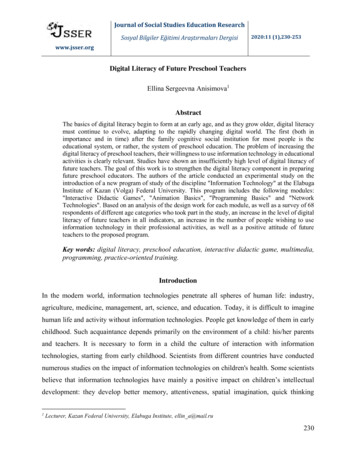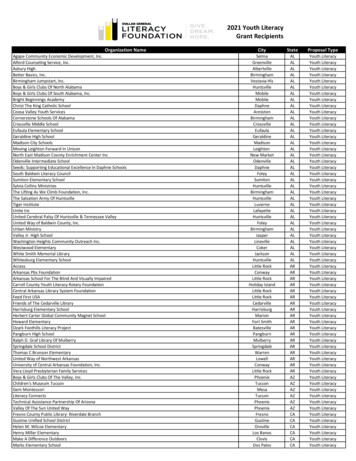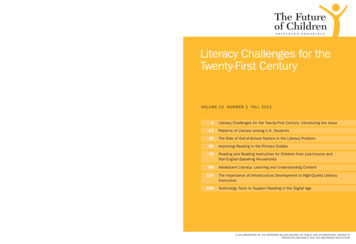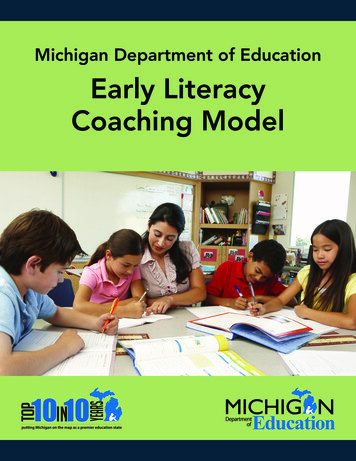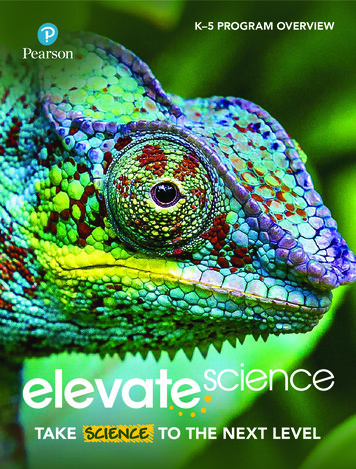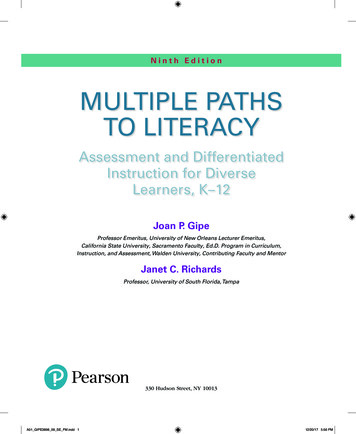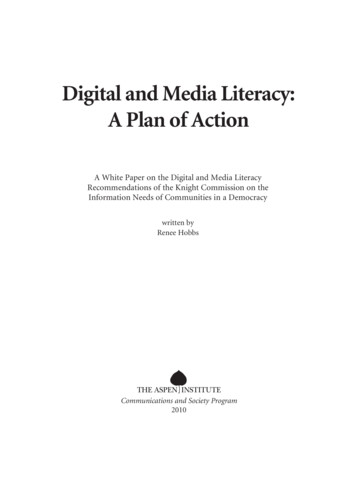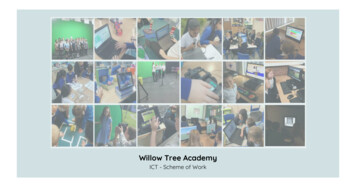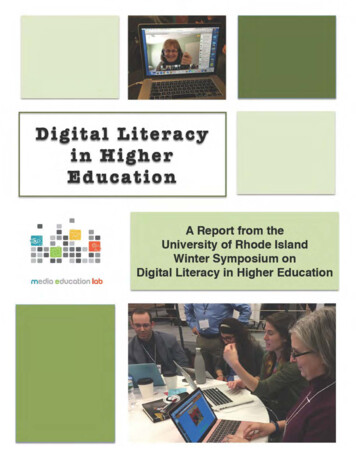
Transcription
Digital Literacy in Higher Education: A ReportAuthorsRenee Hobbs, University of Rhode IslandMaria Ranieri, University of Florence, ItalySandra Markus, Fashion Institute of TechnologyCarolyn Fortuna, Media Education LabMia Zamora, Kean UniversityJulie Coiro, University of Rhode IslandPreferred Citation: Hobbs, R., Ranieri, M., Markus, S., Fortuna, C., Zamora, M. andCoiro, J. (2017). Digital Literacy in Higher Education: A Report. Providence, RI: MediaEducation Lab.1
Digital Literacy in Higher Education: A ReportDIGITAL LITERACY IN HIGHER EDUCATION:A ReportTABLE OF CONTENTSExecutive Summary . 2Introduction . 4Participants . 5Keynote Address: Finding Your Path by T. Mills Kelly 8Show Me Sessions: Hands-on, Peer-to-Peer Learning 9Four Themes .101. Digital Literacy Competencies of Faculty, Undergraduates and Graduate Students .102. Teaching and Learning with and about Digital Media 143. The Digital Identity of the College Professor and Higher Education Professional .194. Scholarly Networking and Digital Literacy .22Key Themes and Insights Gained .23What Faculty Want and Need .25What Participants Learned .26Program Evaluation . 29Anticipated Personal, Curricular and Leadership Actions 32Drafting a Digital Literacy Manifesto .34A Measure of Program Success 35Further Reading .35Other Resources 36About the Media Education Lab .382
Digital Literacy in Higher Education: A ReportExecutive SummaryThis report documents the key ideas that emerged from the Winter Symposium on Digital Literacy inHigher Education, a gathering of 56 higher education faculty held in January 12 – 13, 2017, includingparticipants from the fields of education, communication and media, art and design, the humanities andsocial sciences, along with academic librarians and educational technology specialists.In this report, we share insights that emerged from the program, where participants explored new modelsof professional development to advance knowledge, pedagogy and practice in digital literacy in highereducation. The symposium’s goal was to understand the challenges and opportunities regarding thefuture of digital literacy on college campuses, to determine what research needs exist in this area, and tobrainstorm new approaches to professional development that may advance digital literacy in highereducation.Key ideas include:!!!!Inspiring curiosity and interest in digital literacy. Faculty are inspired by learning about theefforts of colleagues who have experienced success in using digital media and technology toadvance student learningPeer-to-peer sharing. Informal sharing of “good practices” in virtual and face-to-face settingscreates customized learning opportunities for faculty in a risk-free, non-commercial, no-pressureenvironment.Building consensus through disciplinary dialogue. When faculty gather in disciplinary teamsto discuss the particularities of digital literacy within the subject area specialities, they sharedigital literacy practices that can be easily adopted by peers, thus facilitating the transfer ofinnovative pedagogies.Big picture perspective. A mix of faculty (from all 13 colleges and schools in Rhode Islandalong with faculty from 13 states and 3 countries) broadened faculty horizons and remindedfaculty of our profound responsibilities to empower a new generation of students for life, careersand citizenship in an increasing digital and media-saturated society.Throughout the symposium, participants recognized some critical needs for the future:!!A broad political vision about why digital literacy matters. Without a shared understanding ofdigital literacy, disciplinary silos will continue to contribute to uneven digital literacyimplementation. A coherent and broad sense of importance must be linked to our concerns aboutthe future of higher education and the role it serves in an increasingly global and mediatizedsociety. Core value messages about improving learning may imbue all higher educationconstituents with the wherewithal to pursue digital literacy in college classrooms that extendbeyond digitizing traditional practice and, instead, create deeper and more meaningful literacylearning for all.New models of digital literacy professional development. More and more faculty in highereducation recognize the need to advance their own competencies in digital literacy and see thepotential for how it may improve teaching and learning for students enrolled at colleges anduniversities. Because faculty independence is prized, professional development in digital literacy3
!"#" %&'(" )*% ,'"-'."#/)*'012 % "3-4'5'6)73* '!!cannot be mandated. Showcases, awards and recognition of best practices and formal andinformal professional development can support peer-to-peer learning that gives faculty time forsharing and collaboration.Social media networks that extend spaces for scholarship. Networked scholarship istransforming faculty research, learning, and teaching. Faculty are increasingly turning to socialmedia as spaces to build intentionally-designed personal learning networks, understand how tobe networked learners, and uncover ways to model digital communication in their own teachingpractices. Social media create ways for faculty to filter, curate, organize, and navigate informationstreams and need to be further investigated as ways of mitigated academic community building.Support for critical thinking as part of digital literacy frameworks. Digital literacy isinherently tied into critical understanding, critique, use, and assessment of digital tools and texts.Digital literacy is not a mere collection of skills for using technology. Instead, digital literacy isfundamentally an extension of literacy, in which access, analysis, evaluation and reflection arerequired, iterative practices that promote understanding, growth, and learning. Consideration ofethics, habits of mind, socio-emotional competencies and dispositions enable students to developcritical digital literacy competencies.This report on digital literacy in higher education builds upon a peer-to-peer knowledge community (usingthe hashtag #digiURI) that has been exploring digital literacy in elementary and secondary education,school and public libraries, and in higher education institutions for four years.4
Digital Literacy in Higher Education: A ReportIntroductionThe Winter Symposium on Digital Literacy in Higher Education was held in Providence, Rhode IslandJanuary 12 - 13, 2017. The authors acknowledge Jim Purcell, Rhode Island Commissioner ofPostsecondary Education for providing financial support for the Winter Symposium on Digital Literacy inHigher Education. Thanks also go to David Byrd at the School of Education at the University of RhodeIsland and Lori Ciccomascolo of the Alan Shawn Feinstein College of Education and Professional Studiesfor their support of the symposium.The symposium included a mix of large and small group discussions, workshops, and time for networkingand information sharing. Four broad themes were explored: the nature and types of digital literacycompetencies, digital literacy pedagogies, the identity of the college faculty in an age of digital media, andthe functions of scholarly networking as a form of professional learning.The symposium was designed as an invitation-only event and participants included higher educationfaculty and others who were known to us through their scholarship, appearances at conferences, andonline visibility through social networking including Twitter’s #highered and other groups. Representativesfrom among the 13 colleges and universities in the state of Rhode Island were in attendance as well asfaculty from 13 states and 2 countries. We recruited 56 individuals from the following fields:!!!!!!Arts and DesignEducationCommunication and MediaHumanities & Social SciencesAcademic LibrariesInformation TechnologyParticipant ListThe participants helped to generate the ideas developed in this report and we are grateful for their activeengagement, ideas and support. They include:Joseph Amante, Community College of Rhode IslandLucile Appert, Columbia UniversityEmily Bailin Wells, Teachers College, ColumbiaJonathan Becker. Virginia Commonwealth UniversityLinda Beith, Roger William UniversityJillian Belanger, University of Rhode IslandRalph Beliveau, University of OklahomaWhitney Blankenship, Rhode Island CollegeStephanie Branson, University of South FloridaSpencer Brayton, Blackburn CollegeKatelyn Burton, Fashion Institute of TechnologyDavid Byrd, University of Rhode IslandJoshua Calkins, University of Rhode IslandNatasha Casey, Blackburn CollegeAmber Caulkins, College and University Research Collaborative5
Digital Literacy in Higher Education: A ReportLori Ciccomascolo, University of Rhode IslandJulie Coiro, University of Rhode IslandAlec Couro, University of Regina, CanadaJane Cubbage, Bowie State UniversityTerry Deeney, University of Rhode IslandKelly Donnell, Roger Williams UniversityWendy Drexler, Johns Hopkins UniversityPeggy Finucane, John Carroll UniversityJay Fogleman, University of Rhode IslandYonty Freisem, Central Connecticut State UniversityLareese Hall, Rhode Island School of DesignDonald Halquist. Rhode Island CollegeJeanne Haser, Rhode Island CollegeTroy Hicks, Central Michigan UniversityRenee Hobbs, University of Rhode IslandJanet Johnson, Rhode Island CollegeSara Kadjer University of GeorgiaJoanne Kehoe, McMaster UniversityT. Mills Kelly. George Mason UniversityHannah Lee, University of DelawareLu Hongyan, University of Rhode IslandLauren Mandel, University of Rhode IslandJon Marcoux, Salve Regina UniversitySandra Markus, Fashion Institute of TechnologyEileen Medeiros, Johnson and Wales UniversityPaul Mihalildis, Emerson CollegeMary Moen, University of Rhode IslandCharles Morgan, Community College of Rhode IslandLisa Owen, Rhode Island CollegeHailey Posey, Providence CollegeJim Purcell, Rhode Island Commissioner of Higher EducationMohammad Raissa, University of Rhode IslandMaria Ranieri, University of Florence, ItalyTheresa Redmond, Appalachian State UniversityFrank Romanelli, University of Rhode IslandCyndy Scheibe, Ithaca CollegeCandice Simmons, Johnson and Wales UniversitySandra Sneezby, Community College of Rhode IslandKristen Turner, Fordham UniversityJoyce Valenza, Rutgers UniversityClarissa Walker, University of Rhode IslandDavid Wallace, Boston UniversityCarl Young, North Carolina State UniversityMia Zamora, Kean University6
!"#" %&'(" )*% ,'"-'."#/)*'012 % "3-4'5'6)73* 'Figure 156 Participants from 13 States and 3 CountriesThe group was largely from the East Coast of the United States but representation from Canada andItaly helped provide some international context. Faculty affiliations were primarily public universities (N 38) and private universities or colleges (N 18). Two were from community colleges, 1 was from a statedepartment of higher education, and 1 was from a research institute.Roles and ResponsibilitiesParticipating faculty include teachers, researchers, higher education administrators and studentsrepresenting 50 colleges and universities, including public, private and community college institutions.7
Digital Literacy in Higher Education: A ReportKeynote Address: Finding Your Path by T. Mills KellyBy Mia Zamora, rapporteurHiking trails as a powerful metaphor for digital literacyTasked with energizing a diverse group of educators across disciplines, T. Mills Kelly,Professor of History at George Mason University delivered the keynote address at the WinterSymposium on Digital Literacy in Higher Education at the University of Rhode Island. Formerly theassociate director of George Mason's Roy Rosenzweig Center for History and New Media, Kelly hasdeveloped award-winning history website projects funded by the National Endowment for theHumanities.Professor Kelly led participants to think more deeply about the urgency of digital literacies in thecontext of higher education through the use of a meaningful metaphor of the nature trail or the naturepath. As digital literacy is a vast and vexed discussion in the current landscape of 21st centuryeducation, the nature path metaphor helped people think through several questions when consideringwhat digital literacy means for all of us:!!!Do we mean the ability to use digital technologies to accomplish a particular task?Or does digital literacy mean being able to navigate the wilds of the Internet without being takenin by the false information floating around out there?Or does it mean the ability to create digital objects, code something useful, or developvisualizations of large corpora of texts?Introducing himself to the group as a hiker, Mills Kelly drew on his considerable experiences on theAppalachian Trail, America’s oldest and still most iconic long distance hiking trail, to answer suchquestions. Inspired by Robert Moor’s On Trails (2016), Mills quoted: “To put it as simply as possible, apath is a way of making sense of the world. There are infinite ways to cross a landscape; the optionsare overwhelming, and pitfalls abound. The function of a path is to reduce this teeming chaos into anintelligible line.”As he discussed, if we think about digital literacy more as choosing a path through themountains and less like trying to sail across the open ocean, then perhaps we have a chance to find away forward as educators and as scholars in the teeming digital landscape. The notion of the boundlessopen ocean is indeed immobilizing. Just like that notion of the open sea, Professor Kelly pointed outthat when it comes to digital literacy, there are just too many options, too many platforms, too manyapps, too many new ways to navigate the Internet. Indeed at this critical juncture, this reality cancertainly render educators lost at sea.But Professor Kelly reminded us that we are not alone, that there are many educators who wantto teach digital literacy from a diversity of disciplines, who want to improve their own skills in order to doso more effectively. In the end, Mills Kelly grounded participants with his insistence that rather thantrying to define something so broad as “digital literacy,” we instead should think of ourselves aspractitioners on a continuum, who can decide “I’ll just do this,” or, “I’ll just teach my students that.” Heasked us all to think in “steps” rather than grand visions that overwhelm.He reminded us that if one can’t see the destination, we need to remember to simply put onefoot in front of the other, and blaze our own pathway while listening and learning along the way. When8
Digital Literacy in Higher Education: A Reportit comes to thinking about digital literacy in our own practice as teachers, scholars, researchers,citizens, he put it rather succinctly: “Walk, see, but make sure you really see.”Show Me Sessions: Hands-On, Peer-to-Peer Faculty LearningFaculty participated in an informal, elbow-to-elbow style learning experience for sharing ideas,research, programs and instructional practices. Many participants volunteered to share and learn fromeach other in two sessions during the day. Participants explored topics that included:Instructional Practices! Creating videos to make explicit the theoretical connections between past and presentperspectives on media, art, culture and society! Tools, sites and exercises that help students to recognize data, sites or platforms that shouldbe confirmed or interpreted.! Creating robust online dialogue with asynchronous video! Using digital storytelling in an elementary teacher education program! How students compete in meme creation, hashtag creation and “Wikipedia racing“ to help reimagine popular social technologies in more civic ways! New text formats to document the search process: Creating a video anthology! Augmenting library research with a webclipper, students incorporate sustained online grazinginto their research projects! Helping pre-service elementary teachers use digital tools to create literacy lessons and engagein coursework as they create a digital portfolio for future interviewsCourse Development! Faculty and librarian collaboration on the development of a new course in media andinformation literacy! Incorporating student media production activities into undergraduate and graduate education indigital literacy in educationApproaches to Professional Support! Introducing the multimedia design process (pre-production, production, and post-production)and presenting it in a library research guide for students! Creating screencasts to help faculty and students make better use of the most commoninstructional technology tools! Designing a seminar for students, faculty and staff to delve into the basics of digital literacy,data management, and open practices in research and scholarship! Increase visibility for faculty innovation by recording and presenting brief video interviews withfaculty who are using technology to enhance student learning.9
!"#" %&'(" )*% ,'"-'."#/)*'012 % "3-4'5'6)73* 'Four Themes of the Winter SymposiumFour thematic dialogues were developed to capture the complexity of digital literacy in higher educationand each panel was moderated by one of the four co-directors of the symposium. Julie Coiro moderatedthe session on the digital literacy competencies of faculty, undergraduate and graduate students ReneeHobbs moderated the session on teaching and learning with and about digital media. Maria Ranierideveloped and led the session on the digital identity of the college professor and Sandra Markus led thesession on scholarly networking and digital literacy. These sessions provided time for intensivediscussion among a small group of faculty whose insights are described below.PANEL 1. Digital Literacy Competencies of Faculty,Undergraduate, and Graduate StudentsModerator: Julie CoiroQuestions! What are the knowledge, skills, practices, and mindsets of “digital learners” and “digitally literatefaculty”?! What do we want students to know, understand, and be able to do with digital texts and toolsand why/to what end?! Who is responsible for developing these?Process of Inquiry. We used Sharpe & Beetham’s(2011) Digital Literacies Framework to help usbrainstorm digital literacy competencies in fourcategories. These included conditions of access(availability of appropriate tools and Internetconnections); basic skills needed to apply whenlearning with specific technology; flexible practices(where learners make informed choices about how touse technology, alone & with others in response to aspecific content and set of goals); and personalattributes (an individual’s attitude and identity inrelation to their learning with technology). The model assumes that student access can drive thedevelopment of digital skills, and over time, these use of these skills results in effective practices thatenables students to begin to identify with attributes of a confident digital learner. Similarly, the downarrow suggests a student’s attitude towards technology provides motivation to learn new practices,develop new skills, and acquire access to digital texts and tools that meet their needs. To encourage arange of ideas, we shared four models of how others have begun to define teaching and learning in adigital age.10
Digital Literacy in Higher Education: A ReportInsights. For innovation in digital literacy to gain traction in colleges and universities, we first need tobetter understand the complex motivations of faculty who are inspired to take action as well as thosewho are resistant to change. Then, we need to catalogue and classify the different instructionalpractices of digital literacy, looking at how they might be useful in different learning environments, like ina seminar, a lecture, a lab or in online learning. Finally, we need to take stock of the strategies foradvancing faculty development efforts in institutional contexts, including a frank and candid assessmentof “what works” and what is less effective.Motivation & ResistanceParticipants recognized that digital literacy pedagogies are not currently seen as a typicalexpectation of college and university learning environments. They generally saw themselves asenthusiasts or at least “curious” about digital literacy in higher education. Participants described themost common motivational challenges they saw in themselves and their colleagues. They explainedthat many faculty experience: Fear (“I don’t want to be perceived as inexpert”)Lack of time (“I’m already working to the limit of my calendar and so what will Istop doing to learn this new technology?”)Concerns about the loss of traditional academic competencies (“Students needto learn how to listen and take notes from a lecture”)Many participants recognized the value of pointing out what’s not working to help faculty recognizethere is a problem and how digital literacy could be part of the solution. Only when faculty admit thatcurrent approaches are less effective will they be inspired to try new approaches. For example, facultycan easily admit that students don’t engage in critical reading. Demonstrations of how digital annotationtools can be used to support students engagement in reading can be motivational if they are positionedas solving a worthy and important problem.Participants did not see generational patterns of faculty resistance. Some older faculty are activeinnovators in digital pedagogy, and some younger faculty may lack fundamental skills. But participantsrecognized that faculty across career stages may have different sources of resistance. Research couldhelp sort out the different motivations for digital literacy among both older and younger faculty andpotentially identify differences that might also exist among faculty from different fields of study andareas of expertise.Faculty Voices“Part of digital literacy is being open to and exploring what digital resources can helpme or my students meet certain goals and objectives, as well as possibly solveproblems or find answers to questions we may have. Tied to this is defining and beingclear about what our philosophy of teaching and learning is, along with integratingdigital literacy (and defining that as a part of this philosophy as well).”“I think it all stems from motivation. The pedagogy and the faculty development-- orthe desire for development-- won't happen until the motivation question is answered. Itall comes down to our students. They are a reflection of faculty, and if they aren'tbeing prepared for the workforce, then something needs to change. There's a lot of15
Digital Literacy in Higher Education: A Reportfear--- especially with older faculty-- in dealing with change. How do we overcomethis?”The Motivational Power of Peer-to-Peer EngagementMany participants described their own experiences of acquiring digital media competenciesthrough a meaningful real-world engagement with a peer. As one participant put it, “There is value inhaving a trusted friend or colleague who is slightly ahead of where you are in your digital learning.”Examples from members of this group demonstrated that informal instruction, delivered at the point ofneed from a near peer, can be powerful. For example, simple digital literacy competencies, like learninghow to create and upload a screencast, takes on new relevance when someone has a practice needs.When a faculty member needs to share information verbally to many people outside of a face-to-faceexperience, they will be motivated to create a screencast if they have assistance in learning how to doit. Participants wondered about how we could collect stories from faculty members who have had thisform of informal digital literacy learning. We also explored how this peer-to-peer form of learning couldbe made more visible among members of an academic department or knowledge community.IDEA: A college or university creates a digital “thank you” type bulletin board where faculty, staff andstudents offer thanks to people who have helped them learn new digital tools and instructionalpractices.Student-Centered Support for Digital LearningWhile motivation is what leads faculty into exploring new approaches to pedagogy, studentscan be inspired to develop digital literacy competencies on their own. Access to digital resources alongwith active support from academic library staff can be a vital component of independent learning. Oneparticipant described the value of a multimedia design center, where students can check out a variety ofdigital tools to create media. For example, at the Vitale Digital Media Lab, in the Van Pelt Library at theUniversity of Pennsylvania, there is a large assortment of multimedia equipment to help withpresentations and assignments. Students, faculty, and staff can borrow equipment for both academicand personal use.Respect for Disciplinary NormsParticipants recognized that few instructional strategies can be exemplars across all disciplinesand fields. After demonstrating a particular use of video-based discussion tools, one participant recalledhearing from a colleague in another department: “That will never work in my discipline.”Some participants noted that exemplars that are discipline-specific are easy on-ramps. Differentdepartments have different levels of ability to enact digital pedagogies and different levels ofcommitment towards valuing digital literacy competencies. Assignments that are cross-disciplinary havethe opportunity to make digital literacy more relevant and lasting for students, but also to help facultyfind ways to talk across disciplinary boundaries. Digital literacy can be presented as a way to increaseefficiencies. In some departments, for example, there will be a warm response to demonstrations ofhow digital annotation can help provide feedback to assist with grading.The sentiment of the group was that when faculty can see valuable uses for digital media andtechnology in their own discipline, they will be more likely to invest the time and effort to acquireknowledge and skills. Here the concept of near transfer has value for faculty development: facultybenefit from seeing examples of digital literacy pedagogy that are similar enough to current instructionalpractices yet different enough to be considered an improvement.16
Digital Literacy in Higher Education: A ReportIDEA: Digital literacy advocates work collaboratively to create programs to showcase innovativepedagogies at gatherings of disciplinary peers. Sessions are made accessible for those unable toattend. These are archived on department websites.Learning Out LoudMuch academic work that students create is produced only for a grade. This instrumental viewof student academic work is unlikely to cultivate the values needed for life in participatory culture. Whenstudents create work for a larger audience, they gain a appreciation of the gift of knowledge sharing.Pedagogies that emphasize openness, including writing in public, storytelling, service learning,community partnerships, etc. promote a sense of accountability and risk-taking while enabling newforms of expression and creativity that may also lead to the creation of new knowledge.IDEA: Student work is showcased within and across departments to illustrate the value of creatingcontent that is infused with scholarly values but also speaks to a wider audience.Focus on Learning OutcomesFaculty in some disciplines value an outcomes orientation, helping students see how variousassignments and activities are aligned with leading to an internship, a job, a new way of thinking aboutthe world. As we explored ideas about why developing digital literacy helps students achieve theirpersonal goals, participants noted that students themselves generally do recognize the value ofdeveloping the soft skills they need for the world of employment (e.g., problem solving, ability to work inteams, tenacity and persistence). But faculty may need help in seeing the value of using digital mediatools and pedagogies to gain knowledge or better understand a discipline or a problem within adiscipline.When digital literacy is framed in terms of student success, the overall theme is that thispedagogy empowers learners and increases their ability to manage their own learning processes.Digital pedagogies have the opportunity to empower students by giving them more control - morechoice and voice - over the learning experience.Time to Work TogetherFaculty meetings are filled with talk and ideally, this talk should lead to action that improvesacademic programs and teaching and learning. But what if faculty meetings became places whenpeople spent time creating collaborative work? What if digital tools were used to help faculty talk andcreate together? Participants emphasized the need to provide new models of digital literacy practicesintegrated with good pedagogy.Faculty VoicesEngaging faculty requires collaboration, both within the department and acrossdisciplines. Sharing pedagogies and strategies reinforces student learning as well ashelping faculty develop and strengthen their own skills.“I have been feeling the need to create new models for this, like near-peer coaching atpoint of need. I am reflecting on how, with my own digital literacy learning, oneperson's suggestion/idea/modeling had dramatic and major impact on my work as ateacher and researcher. This informal instruction happened just when I needed it.”17
Digital Literacy in Higher Education: A ReportWorkshops don't work simply because it is too much information, too fas
The Winter Symposium on Digital Literacy in Higher Education was held in Providence, Rhode Island January 12 - 13, 2017. The authors acknowledge Jim Purcell, Rhode Island Commissioner of Postsecondary Education for providing financial support for the Winter Symposium on Digital Literacy in Higher Education.
